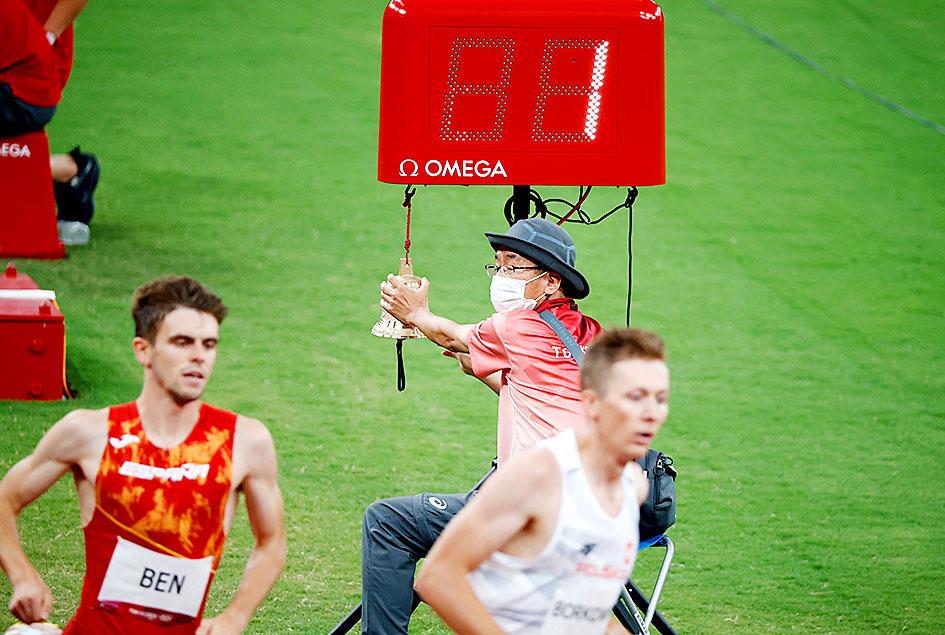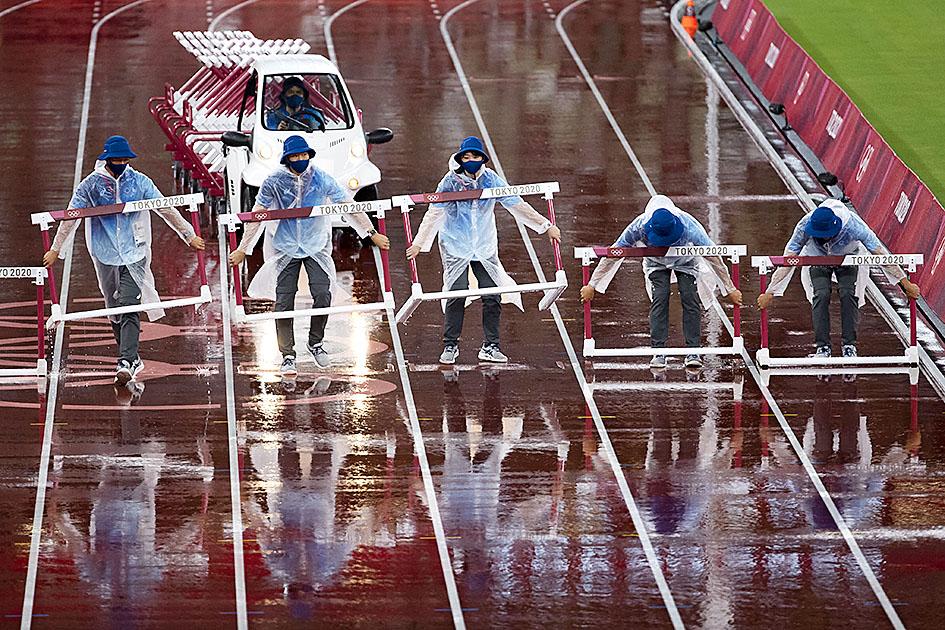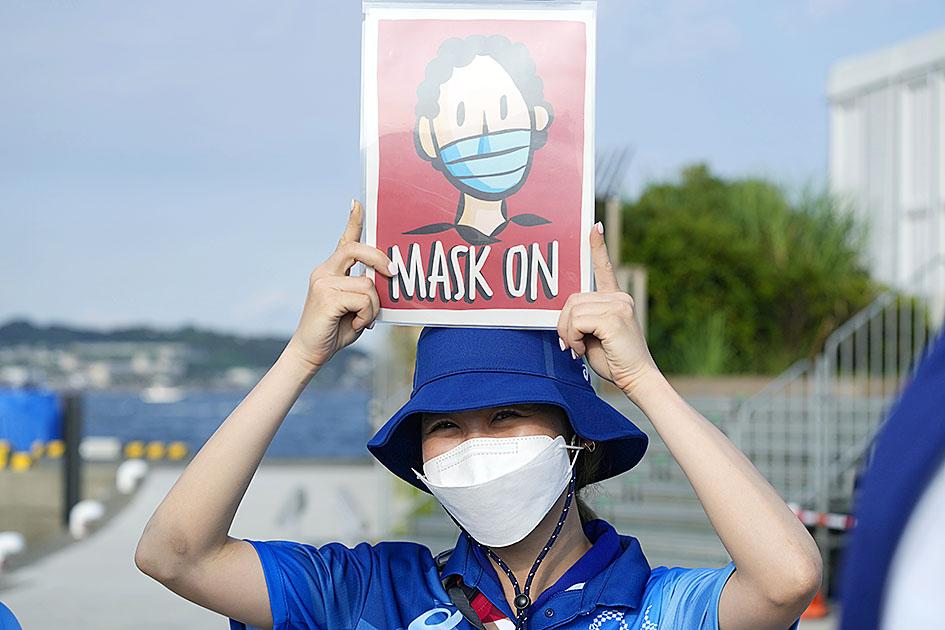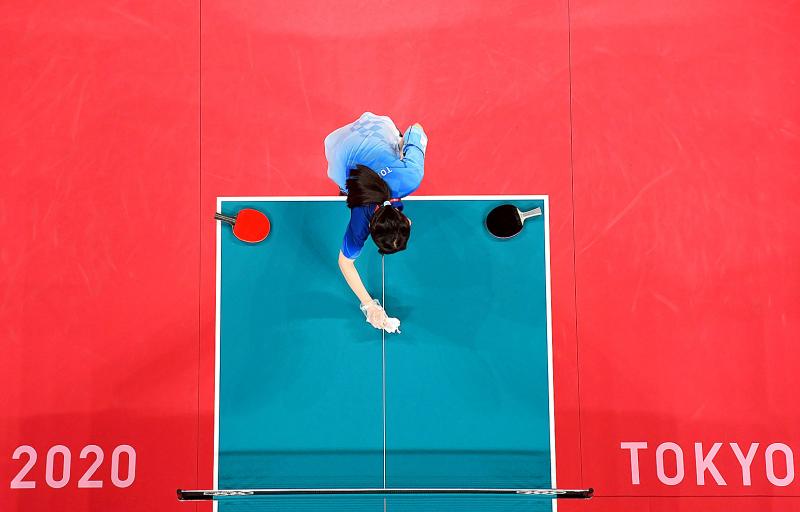In order to volunteer at the Tokyo Olympics, Tsan Wong from Hong Kong and his wife Rever Yau are spending around US$5,000 on flights, evening meals and mandatory hotel quarantine back home.
Under virus rules, the army of overseas volunteers that are usually part of an Olympics has largely been scrapped.
And it is only those with specialist expertise, such as former Commonwealth fencing champion Wong, who have been able to come from abroad to volunteer.

Photo: Reuters
Strict “bubble” rules confined the pair to their hotel and the fencing venue, where Wong managed the warm-up zone and Yau worked as an information coordinator.
“Some fencers and coaches are very tense before the competition. I understand what they are thinking, so I try and help them relax,” Wong, 55, said.
Wong is president of Hong Kong Fencing School, where gold medalist Edgar Cheung Ka-long (張家朗) trained as a teenager, though he did not get to see Cheung’s winning bout from behind the scenes.

Photo: EPA-EFE
But despite the conditions, and having to take a month off work, Wong has no regrets.
“I really enjoy it here,” he said. “Even though they gave me a rest day, I didn’t rest. They have a nine-day competition, and I worked nine days.”
Hundreds of keen volunteers had hoped to travel from abroad to work at Tokyo 2020, but most were told they could not attend when overseas spectators were banned in March.

Photo: EPA-EFE
So hockey enthusiast Bruce Danbury, who has helped at many tournaments including previous Olympics, feels “very lucky and very privileged” to be in Tokyo.
Usually, he’s part of a big group of British volunteers — but this time, “it’s just me”, the 45-year-old told AFP.
‘WORTH GOING’

Photo: Reuters
“It’s given me so much, so it’s great to put a little back into the sport where I can,” he said. “I just look at it as quite an expensive holiday, but working 15 hours a day instead of sitting on a beach.”
Danbury’s job is technical, looking after pitch irrigation to make sure the playing surface is consistently in top condition.
“It’s a really special opportunity to be involved in an Olympic Games, and being at my third one in a row brings home how amazing these athletes are,” he said.
British volunteer Miranda Staveley also brings specialist knowledge to the Games, and when a horse risked overheating at an Olympic equestrian event, she knew exactly what to do.
“You have to cool the horse down really quickly when they stop, because it’s so hot. It’s really dangerous,” said the 32-year-old, who has competed in equestrian sports since childhood.
She grabbed a bucket of iced water and washed down the horse, which went on to complete the cross-country course — and even won a bronze medal.
“Because I’m extremely horsey, I could step into that role really easily,” said Staveley, whose day job is in IT.
She volunteered as an equestrian jump judge in London and Rio, but costs and quarantine uncertainties meant she nearly did not make it to Tokyo when the Olympics were postponed by the pandemic.
“I hadn’t been planning on going, because I didn’t think it was going to happen, to be honest,” she said.
But helping at crucial moments, meeting other specialists and training Japanese volunteers has made it “definitely worth going,” she added.

The canonical shot of an East Asian city is a night skyline studded with towering apartment and office buildings, bright with neon and plastic signage, a landscape of energy and modernity. Another classic image is the same city seen from above, in which identical apartment towers march across the city, spilling out over nearby geography, like stylized soldiers colonizing new territory in a board game. Densely populated dynamic conurbations of money, technological innovation and convenience, it is hard to see the cities of East Asia as what they truly are: necropolises. Why is this? The East Asian development model, with

June 16 to June 22 The following flyer appeared on the streets of Hsinchu on June 12, 1895: “Taipei has already fallen to the Japanese barbarians, who have brought great misery to our land and people. We heard that the Japanese occupiers will tax our gardens, our houses, our bodies, and even our chickens, dogs, cows and pigs. They wear their hair wild, carve their teeth, tattoo their foreheads, wear strange clothes and speak a strange language. How can we be ruled by such people?” Posted by civilian militia leader Wu Tang-hsing (吳湯興), it was a call to arms to retake

This is a deeply unsettling period in Taiwan. Uncertainties are everywhere while everyone waits for a small army of other shoes to drop on nearly every front. During challenging times, interesting political changes can happen, yet all three major political parties are beset with scandals, strife and self-inflicted wounds. As the ruling party, the Democratic Progressive Party (DPP) is held accountable for not only the challenges to the party, but also the nation. Taiwan is geopolitically and economically under threat. Domestically, the administration is under siege by the opposition-controlled legislature and growing discontent with what opponents characterize as arrogant, autocratic

When Lisa, 20, laces into her ultra-high heels for her shift at a strip club in Ukraine’s Kharkiv, she knows that aside from dancing, she will have to comfort traumatized soldiers. Since Russia’s 2022 invasion, exhausted troops are the main clientele of the Flash Dancers club in the center of the northeastern city, just 20 kilometers from Russian forces. For some customers, it provides an “escape” from the war, said Valerya Zavatska — a 25-year-old law graduate who runs the club with her mother, an ex-dancer. But many are not there just for the show. They “want to talk about what hurts,” she